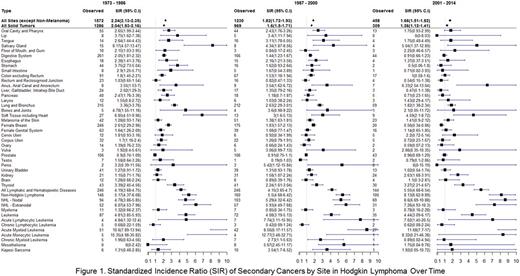Abstract
OBJECTIVES: The impact of treatment modifications including replacement of alkylating agents based regimens and improvement in the practices of radiation oncology on the risk of secondary cancers (SCs) in Hodgkin's lymphoma (HL) survivors is unknown in the United States (U.S.). This study analyzed the trends of secondary cancer risks among the survivors of HL in the U.S.
METHODS: The HL patients diagnosed during 1973-2014 were identified from the Surveillance, Epidemiology and End results (SEER) database. Due to differences in the treatment practices in HL, the whole cohort was divided into three time-periods: 1973-1986, 1987-2000 and 2001-2014. We compared the risk of SCs in the HL patients with the risk expected in the U.S. general population over the three study periods.
RESULTS: With a follow-up of 23,864 HL survivors for 284,730 person-years (PY), 3260 secondary cancers were diagnosed, with standardized incidence ratio (SIR) of 1.97 (95% CI, 1.9-2.04) which resulted in 56.56 excess cancers per 10,000 person-years. SIR for any SCs in women (SIR 2.17; 95% CI 2.06-2.28) was significantly higher than in the men (SIR 1.84; 95% CI 1.75-1.92). The highest SIRs were observed for AML (SIR, 9.9; 95%CI, 8.3-11.9), NHL (SIR, 5.8; 95% CI, 5.3-6.4) and salivary gland tumors (SIR, 6.04; 95% CI, 4-8.8) while lung cancer (23.6%) and breast cancer (27.4%) contributed most to the excess risk in males and females respectively. The SIR for any SCs was maximum in the period after 15 to 20 years from the diagnosis of HL and remained high for more than 20 years after the diagnosis of HL (SIR for ≥ 20 years, 2.34; 95% CI, 2.19 to 2.5). A statistically significant decrease in the overall SIRs of SCs was observed in HL patients diagnosed during 1987-2000 (SIR 1.82 95% CI 1.72-1.93) and 2001-2014 (SIR 1.66 95% CI 1.51-1.82) as compared to the patients diagnosed in 1973-1986 (SIR 2.24 95% CI 2.13-2.35). (Figure 1) The decline in the overall SIR was mostly due to decline in the digestive tract and breast cancers. The SIRs of most of the other solid tumors and hematological malignancies including individual risks for NHL and AML did not decrease in the more recent study periods. Moreover, the decline in the SIRs of solid tumors was noticed only in the patients age below 60 years old. The female patients diagnosed in the most recent period were at lower risk of developing breast cancers (SIR 0.56 95% CI 0.34-0.86) as compared to the general population. The decline in the risk for secondary cancers was observed only after 10 years from the diagnosis of HL. After making adjustments for age, gender and race, patients diagnosed during 1973-1986 were at 12% higher risk of developing SCs (HR 1.12 95% CI 1.03-1.23 p=0.01) as compared to the patients diagnosed during 1987-2000. The hazard ratio for developing SCs in the patients diagnosed during 2001-2014 was not different from the patients diagnosed during 1987-2000 (HR 1.02 95% CI 0.9-1.2 p=0.74).
CONCLUSIONS: Although, the overall risk of secondary cancers in patients with Hodgkin's lymphoma has declined after the modifications in Hodgkin's lymphoma treatment, apart from the digestive tract and breast cancers the risk has not changed significantly at most of the individual sites. The risk of secondary cancers is still 70% higher than the general population and is maximum 15-20 years from the diagnosis of Hodgkin's lymphoma. Thus close follow up with active surveillance for secondary cancers is crucial for the long term survivors of Hodgkin's lymphoma.
Ailawadhi: Novartis: Consultancy, Honoraria; Pharmacyclics: Research Funding; Takeda: Consultancy, Honoraria; Amgen: Consultancy, Honoraria.
Author notes
Asterisk with author names denotes non-ASH members.


